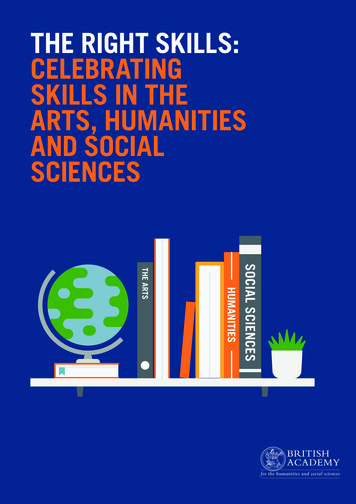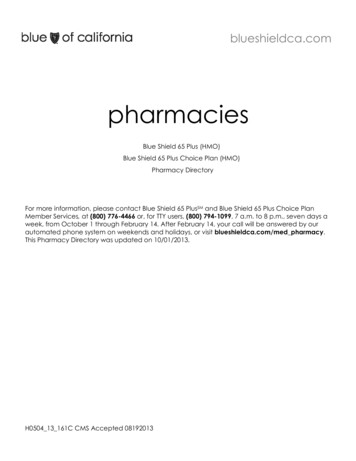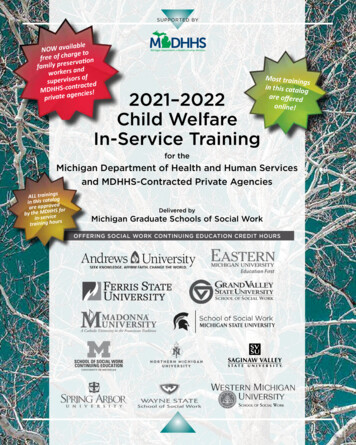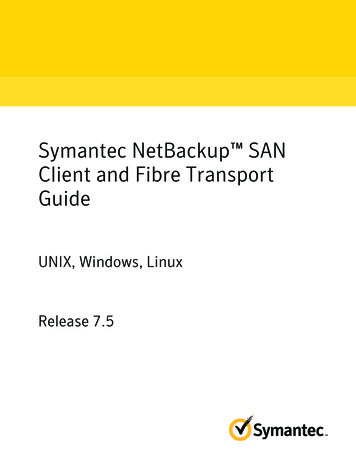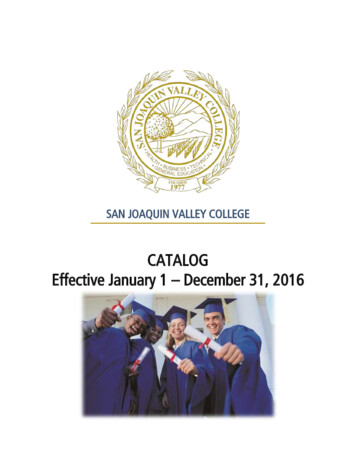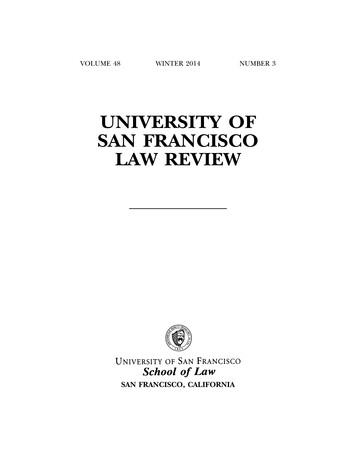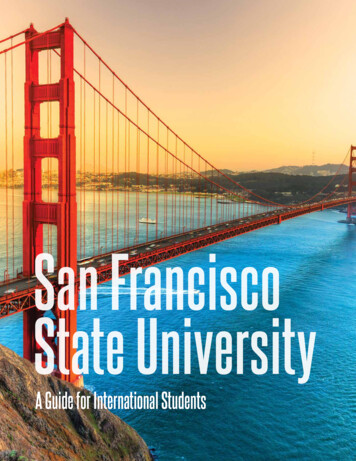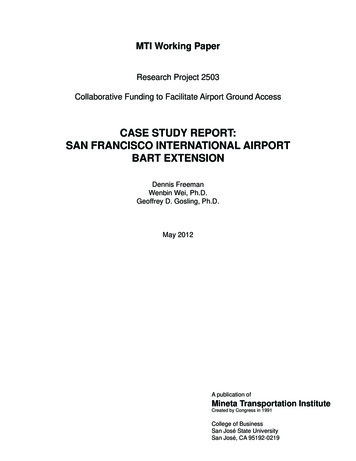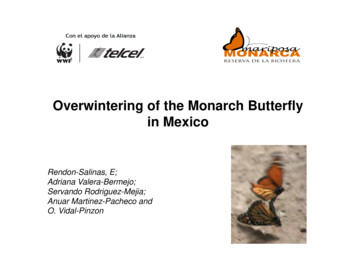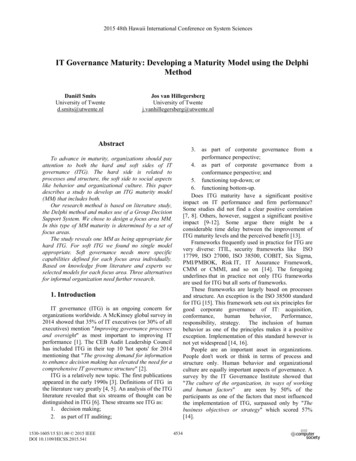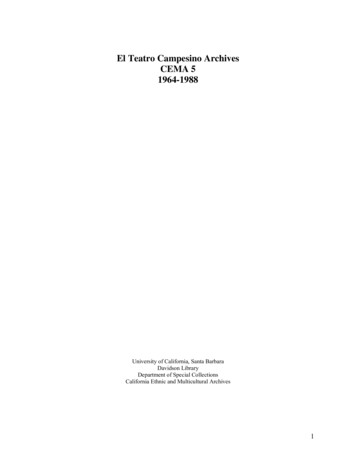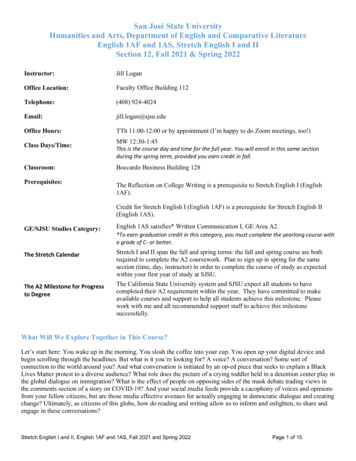
Transcription
San José State UniversityHumanities and Arts, Department of English and Comparative LiteratureEnglish 1AF and 1AS, Stretch English I and IISection 12, Fall 2021 & Spring 2022Instructor:Jill LoganOffice Location:Faculty Office Building 112Telephone:(408) 924-4024Email:jill.logan@sjsu.eduOffice Hours:TTh 11:00-12:00 or by appointment (I’m happy to do Zoom meetings, too!)Class Days/Time:Classroom:Prerequisites:MW 12:30-1:45This is the course day and time for the full year. You will enroll in this same sectionduring the spring term, provided you earn credit in fall.Boccardo Business Building 128The Reflection on College Writing is a prerequisite to Stretch English I (English1AF).Credit for Stretch English I (English 1AF) is a prerequisite for Stretch English II(English 1AS).GE/SJSU Studies Category:English 1AS satisfies* Written Communication I, GE Area A2.*To earn graduation credit in this category, you must complete the yearlong course witha grade of C- or better.The Stretch CalendarStretch I and II span the fall and spring terms: the fall and spring course are bothrequired to complete the A2 coursework. Plan to sign up in spring for the samesection (time, day, instructor) in order to complete the course of study as expectedwithin your first year of study at SJSU.The California State University system and SJSU expect all students to havecompleted their A2 requirement within the year. They have committed to makeavailable courses and support to help all students achieve this milestone. Pleasework with me and all recommended support staff to achieve this milestonesuccessfully.The A2 Milestone for Progressto DegreeWhat Will We Explore Together in This Course?Let’s start here: You wake up in the morning. You slosh the coffee into your cup. You open up your digital device andbegin scrolling through the headlines. But what is it you’re looking for? A voice? A conversation? Some sort ofconnection to the world around you? And what conversation is initiated by an op-ed piece that seeks to explain a BlackLives Matter protest to a diverse audience? What role does the picture of a crying toddler held in a detention center play inthe global dialogue on immigration? What is the effect of people on opposing sides of the mask debate trading views inthe comments section of a story on COVID-19? And your social media feeds provide a cacophony of voices and opinionsfrom your fellow citizens, but are those media effective avenues for actually engaging in democratic dialogue and creatingchange? Ultimately, as citizens of this globe, how do reading and writing allow us to inform and enlighten, to share andengage in these conversations?Stretch English I and II, English 1AF and 1AS, Fall 2021 and Spring 2022Page 1 of 15
In this class, we’ll use the New York Times as a text to initiate our inquiry into these kinds of questions (and more!). Aswe scroll through the digital pages each week, we will go deeper into our exploration of the role that reading and writingplay in our exchange of ideas and democratic dialogue. And ultimately, we will ask ourselves whether or not the NewYork Times, itself, works as a forum for democratic dialogue and activism. We have much exploration ahead of us. Solet’s begin our inquiry together What Will I Learn in Stretch English I and II?As part of your general university education, you are offered this course to explore how reading and writing inform thework we do together at the university. Across the university, in all disciplines and majors, reading and writing inform thecollaborations between students and faculty as we create new knowledge together. Here’s how the SJSU Catalogdescribes us:Stretch I and II, together, fulfill the Written Communication I requirement. Courses in GE Area A2 cultivate anunderstanding of the writing process and the goals, dynamics, and genres of written communication, with specialattention to the nature of writing in the university. Students in these courses develop college-level reading abilities,rhetorical sophistication, and writing styles that give form and coherence to complex ideas and feelings. A grade of C- orbetter signifies that the student is a capable college-level writer and reader of English.The General Education guidelines for instructors outline five broad learning outcomes for all courses that satisfy Area A2.I have designed this course to ensure that you meet these outcomes.GE Learning Outcomes (GELO)Upon successful completion of this course, students will be able to:1. demonstrate the ability to read actively and rhetorically2. demonstrate the ability to perform the essential steps in the writing process (prewriting, organizing, composing,revising, and editing) and demonstrate an awareness of said performance3. articulate an awareness of and write according to the rhetorical features of texts, such as purpose, audience, context,and rhetorical appeals4. demonstrate the ability to integrate their ideas and those of others by explaining, analyzing, developing, and criticizingideas effectively in several genres5. demonstrate college-level language use, clarity, and grammatical proficiency in writingFor more information on the Stretch Curriculum deigned to meet these learning outcomes, see the Stretch EnglishProgram Syllabus. Table 1 maps how the yearlong course will meet Written Communication I requirements and standardsas well as the GE learning objectives.AssignmentAssignment (Word Count)Critical reading/reflectionEssay 1:(600)Essay 2:(750)Essay 3:(750)Personal Essay(1000)Interview Project (1000)Ethnography Project (800)NYT Opinion Piece (750)Profile Essay(1000)Critical Essay(1200)Midyear(750)Final(1000)Data-driven analysesMajor 0AssignmentTypeIn-class writing2800Out of classwriting2950Out of classwritingIn-class writingOut of classwritingTable 1: Summary of Writing Assignments for Stretch English I and II.1750Stretch English I and II, English 1AF and 1AS, Fall 2021 and Spring 2022Term GE LearningObjectiveFFGELO 1, 2, 3,4, 5SFSGELO 2, 3, 5SFSGELO 2, 3, 4, 5SFSGELO 1, 2, 3, 4, 5Page 2 of 15
How Should I Prepare for Our Class?You can start by coming to each class ready to go – to explore ideas, dialogue with your peers, share research and reading,analyze source materials, critique samples, and workshop drafts. All classes will involve in-class activities intended tofurther your progress on the current essay assignment or project. You will want to save this classwork as we go. Thereforeyou will probably want to bring your own laptop or tablet. (Laptops and tablets are also available to be checked out in thelibrary. If you have difficulty securing a laptop, please let me know as soon as possible.)Where Can I Find Assignments and Materials?Course materials such as syllabus, handouts, assignment sheets, and some readings can be found on Canvas. Rememberto check your SJSU email to learn of any updates to our schedule.Where Can I Purchase the Texts?Reading is an integral part of writing. Reading for this course is both extensive and intensive. It includes useful samples ofwriting for a variety of audiences. You will read stories daily in The New York Times (International), as well as a book onthe media and various articles and essays on citizenship, activism, and more. You will also have texts that discuss thewriting process, as well as a style guide that explore the finer intricacies of writing. Notice that you will need the booksbelow for both semesters; therefore I recommend buying them rather than renting them.The following textbooks are available through the Spartan Bookstore or through Amazon.Ballenger, Bruce. The Curious Writer, Brief (5th Edition) (Do not get the “Concise” edition)ISBN: 978-0134703268Clark, Roy Peter. Writing Tools (6th Edition)ISBN: 978-0316014991Gladstone, Brooke. The Influencing Machine: Brooke Gladstone on the Media (2021 edition)ISBN: 978-0393541571Little Seagull Handbook w/ Exercises (3rd Edition) OPTIONALISBN: 978-0393602630How do I subscribe to the New York Times?Together we are embarking on an exploration of the role reading and writing play in being a global citizen pursuingdemocratic action. To study that relationship, we are going to read the newspaper and share our learning and experiencesin writing. SJSU studies include an emphasis on diversity, so I chose The New York Times as the main text for our readingprecisely because, in its pages, you will find and engage in a full range of voices in our democratic conversation on globalissues.You will need to purchase a digital version of The New York Times for the full year ( 1.00 per week). This digital versionwill allow you to keep a personal archive of stories you are following for your writing assignments in this course. Use thefollowing link to access the educational subscription page. You will use your MySJSU account (@sjsu.edu) to set up aspecial education rate for the subscription: html?mcubz 1Other ReadingsOther readings are available as PDF documents that you may download from Files on our Canvas site. On occasion I willalso provide links to readings that can be found online.Stretch English I and II, English 1AF and 1AS, Fall 2021 and Spring 2022Page 3 of 15
What Work Will We Do in This Course?The Core Stretch Curriculum. Table 1outlined the major writing assignments forStretch English. All sections of StretchEnglish share this core curriculum. The fallwriting assignments include: 2 criticalreading and reflection essays, written inclass; a personal essay; an blog essay; aself-reflection essay (written in class). Thespring writing assignments include: aninterview project, a profile essay, acritical/reflection essay (written in class),an ethnographic project, a critical essay,and a self-reflection essay.Midyear and Year-End Self-Reflectionand Portfolio ReviewAt the end of the fall and spring terms youwill submit a portfolio for Stretchinstructors to review. These portfolios willask you to enter into an assessment of yourwriting with two members of the Stretchfaculty: me and one of my colleagues.Our Daily Learning Activities.The schedule of reading and writingassignments at the end of this syllabusbreaks this work down into daily activitiesyou will engage both in and out of class.The Time You Will Spend on This WorkLike all faculty at SJSU, I have designedthis course to help you achieve the learninggoals that define its role in your progress toearn a degree. In a 3-unit course like thisone, faculty expect that students will spenda minimum of forty-five hours for eachunit of credit (normally three hours per unitper week). This time includes preparing forclass, participating in course activities,completing assignments, and so on. Moredetails about student workload can befound in University Policy S12-3 athttp://www.sjsu.edu/senate/docs/S12-3.pdf.While all students will complete thesesame assignments, please take into accountyour own specific needs as a student. Theremay be added work you need to do. Forexample, you may need extra hours fortutoring; or you may take longer to readtexts so that you can look up words youfind unfamiliar; or you may need moretime for editing.Reflecting on Your Own Learning: The Stretch Course LearningOutcomes (CLO)When you have completed this coursework, you will have madeconsiderable progress in developing yourself as a reader and writer. Atthe end of the fall and the spring term, you will assemble this work ina portfolio, and reflect on the work to gauge and define your progress.Presenting this portfolio to me and to one other member of the StretchFaculty Learning Community, you will demonstrate to us your ownability to:Read to learn: annotate a reading selection to develop a summary andresponse in your writing (GELO1); identify audience and purpose in texts from several genres(GELO 1,3,4); explain how genres work to serve audience and context(GELO 1, 3).Read to write: identify rhetorical appeals and devise strategies for aneffective appeal to a specific audience (GELO 1, 3); develop a text to effectively appeal to a specific audience(GELO 1, 3); identify the choices a writer has made to produce a text(GELO 1, 3, 4); use readings as models for your own writing strategies(GELO 1, 4); concisely, accurately explain and critique information andideas from your reading (GELO 1, 3, 4); use information gleaned from your reading as evidence inyour text and cite that information (GELO 1, 4); use quotation and summary to create context for your writing(GELO 1, 4, 5).Write with an increased awareness of the process: discuss specific strategies for prewriting and revision thathave worked for you (GELO 2); repurpose acquired skills and information to tackle newwriting problems (GELO 2).Read and write with an increased awareness of the language youuse: identify new grammatical forms and imitate them (GELO 1,2, 3, 4, 5); analyze and discuss the structure of sentences and thegrammatical choices you make (GELO 2, 3, 5); identify editing problems in your own writing (GELO 2, 5); identify and apply effective strategies for editing your work(GELO 2, 5); identify and apply effective proofreading strategies (GELO 2,5);Reflect on and assess your own writing, process and product, tosupport continued language and writing development (GELO 2, 3, 4).Stretch English I and II, English 1AF and 1AS, Fall 2021 and Spring 2022Page 4 of 15
Your goal in this class is to learn what you need in order to develop your skills as a writer—and to get what you need.That will take commitment, of your time and your attention, to the work of this class; commitment to seek out the supportand resources you need, both in class and out of class. Be sure to factor the time and attention you need to develop yourwriting skills into your study plan for this semester.How Will We Evaluate My Progress?Your Stretch colleagues and I will provide you feedback on your work to help you apply lessons learned in each activityto the next assignment and to transfer lessons learned from one assignment to the next. In this process, grades are a toolfor assessment and course correction within your journey to become an independent writer; they report outcomes during acourse of instruction.My grading practices respect your right to feedback within a reasonable time so that you may not only know your scores,but also understand the criteria applied to the evaluation of your work. I will give you feedback in the form of rubrics,short notes, longform comments, annotations, and written dialogues with you. However, our goal is to work together tomake you an efficient and effective evaluator of your own work.See University Policy F13-1 at http://www.sjsu.edu/senate/docs/F13-1.pdf for more details on your right to understandyour grades.What Is My Role in Assessing My Own Learning in This Curriculum?Learning to explain what you have learned through the coursework reinforces your learning and helps Stretch facultyunderstand the effects of our curricular designs. In both fall and spring you will turn in an e-Portfolio of your Stretchwriting, along with an essay that reflects on your progress toward achieving the course learning objectives.Your SJSU Writing Portfolio. In summer, you wrote essays to reflect on college writing before deciding to take StretchEnglish. In the first two weeks of the course, you will compile the writing you submitted to the Reflection on CollegeWriting modules into a digital portfolio. The contents of your portfolio will be reviewed twice during your Stretch study. Midyear Self-Reflection and Portfolio Review. At the end of the fall term, you will add to your writing portfolio1) samples that document your progress in the first half of the course and 2) a reflection essay comparing thesesamples. Written as a timed draft, the reflection essay compares the two samples to help the Stretch faculty toassess your midyear progress toward the Course Learning Outcomes listed on page 3.Final Self-Reflection and Portfolio Review. At the end of Stretch II, you will once again add to your SJSUwriting portfolio, this time including materials to document and samples to illustrate your progress on one of thefive GELOs for A2. When you submit the portfolio, you will once again write a self-reflection essay to help theStretch faculty readers as they make this final assessment of your progress to proficiency as a college writer. Thisportfolio is your culminating exercise in this class.How Will Individual Assignments Be Evaluated?For each assignment, I will give you a rubric so that you will have a clear understanding of how and why the work isbeing evaluated the way it is. Keep in mind that our work here is not just to create written products, but to continuallyimprove your reading and writing processes. This means that you will also be turning in Reflections on your work so thatyou and I can both evaluate the effectiveness of your writing process. Other assignments include:Canvas Discussions/Story ResponsesBefore most classes you will be required to post a Discussion post on Canvas so that we can use it as a springboard for ourdiscussions and writing in class. Monday’s responses will mainly be Story Responses, in which you update your peersabout NYT stories related to your topic and engage with them in inquiry related to those stories. For other discussions, Iwill post a specific prompt and you will write a response to it. Some will be creative, while others will be more critical.Please enter them in the text box rather than as attachments.Stretch English I and II, English 1AF and 1AS, Fall 2021 and Spring 2022Page 5 of 15
In-class ActivitiesThese activities will be designed to help with various stages of the writing process and to facilitate our discussionsthroughout the year. I will give individual instruction on these during class time. Often they will require you to turn insomething to me. Bringing the required texts to class will also be part of the In-Class Activity grade. Some of theseactivities will be Individual/Team quizzes, which I will explain during class. Because these activities require the dynamiccollaboration of our class, In-class Activities cannot be made up, and In-Class Activity points will not be awarded if youare late.ReflectionsYou will submit a Reflection after most major assignments. In the Reflection, you will discuss your process and submitsupporting documentation to help us both to examine your process.How Assignments Are Weighted to Determine GradesFall 2021: Grades in the fall are based on measured progress toward proficiency in the learning objectives outlined above. Toearn credit in the course, you will need to demonstrate measurable progress in at least 3 out of 4 (75%) of the CLO categoriesto earn credit (CR) in English 1AF.ItemCritical Reading/Reflection 1Personal EssayNYT Opinion PieceCritical Reading/Reflection 2Self-Reflection/Midyear PortfolioActivitiesDiscussions/Story ResponsesReflectionsEditing Journal% of Course GradeWord Fall Total[39%]Spring 2022: A final grade of C- or better in English 1AS is needed to satisfy GE Area A2.ItemInterview TranscriptProfile EssayEthnography PresentationCritical Reading/Reflection 3Critical EssaySelf-Reflection/Final PortfolioActivitiesDiscussions/Story ResponsesReflectionsEditing Journal% of Course GradeWord N/AN/AN/ASpring Total[61%]Word Count / Fall and Spring: 9550 (5150 finished writing)How Will My Grade Be Calculated?Stretch English I and II, English 1AF and 1AS, Fall 2021 and Spring 2022Page 6 of 15
In Stretch English, your course grade is based on the grades you earn on the work you produce through both semesters.Final grades will adhere to this grading scale:A 93-100%A- 90-92.9%B 87-89.9%B 83-86.9%B- 80-82.9%C 77-79.9%C 73-76.9%C- 70-72.9%D 67-69.9%D 63-66.9%D- 60-62.9%F 0%-59.9%How Will Late Work Be Assessed?For assignments submitted late, 10% will be deducted for each day it is late, up to three days. After that the assignmentwill receive no credit. (As a reminder, I will not accept late work for In-Class Writing Activities.)What Can We Expect from Each Other to Make This Class an Effective Learning Experience?To help foster a positive classroom community, I expect that you will treat each other and me with respect and dignity atall times, even when sharing opposing views on controversial topics, and that you will attend class regularly and give yourfull attention to the task at hand.You can expect that I will treat you as an individual, and that I will challenge you to think. I am happy to talk to youabout any concerns or questions you may have by email or during my office hours. You can trust that I will make myselfavailable to you for individualized help, that I will be honest with you, and that your growth as a reader and writer is at theheart of my intents.What happens if I don’t earn credit in the Fall course?If you earn No Credit in the fall, you will enroll in English 1A in the spring. If you successfully complete the springEnglish 1A (with a grade of C- or better), you will still complete your A2 requirement within your first year of study atSJSU.What Should I Know About GE Area 2 Policy and Yearlong Grading in Stretch?In keeping with GE policy, your final course grade for English 1AS will be a letter grade: A to F. You must earn a C- orbetter to receive graduation credit for GE Area A2. English 1AF is graded CR/NC. To receive credit in the fall semester,you must complete all coursework and demonstrate significant, measurable progress throughout the semester that suggestsyou are on track to earn a C- or better in the spring term.Your spring grade in Stretch includes the grades you earned in fall. All the work you do in Stretch I and II, fall and springcombined, complete one general education course requirement: GE Area A2.How Do I Earn Credit for GE Area A2?To satisfy your CORE GE Area A2 and to move on to CORE GE Area A3, you must earn at least a C- in English 1AS.1. When you earn a C- or better in the course, you can be confident that you have successfully oriented your reading andwriting practice in English to support college level research and learning and to share your learning with others.2. See University Policy F13-1 at http://www.sjsu.edu/senate/docs/F13-1.pdf for more details on your right tounderstand your grades.Where Can I Find Information about University Policies?The Office of Graduate and Undergraduate Programs (GUP) maintains university-wide policy information relevant to allcourses, such as academic integrity, accommodations, etc. You may find all syllabus-related University Policies andresource information listed on GUP’s Syllabus Information web page at http://www.sjsu.edu/gup/syllabusinfo/Where Can I Find Information about Earning A2 Credit?The Stretch program syllabus is also located in our Canvas files. In that syllabus you will find information about how youcan earn A2 credit in Stretch I and II. Keep in mind that you will need to earn at least a C- in the yearlong course to earnan A2 credit.Stretch English I and II, English 1AF and 1AS, Fall 2021 and Spring 2022Page 7 of 15
Where Can I Go to Get Writing Support?Part of becoming a successful writer is learning how and when to seek the support you need. Jill, of course, is here to helpyou. But there are other resources, too: SJSU Writing CenterLocated in Clark Hall, Suite 126, the Writing Center offers appointments with tutors who are well trained to assist youas you work to become a better writer. The Writing Center offers both one-on-one tutoring and workshops on a varietyof writing topics. To make an appointment or to refer to the Center’s online resources, visit the Writing Center websiteat http://www.sjsu.edu/writingcenter. For additional resources and updated information, follow the Writing Center onTwitter and become a fan of the SJSU Writing Center on Facebook. SJSU Peer ConnectionsPeer Connections offers course-content based tutoring, enhanced study and time management skills, more effectivecritical thinking strategies, decision making and problem-solving abilities, and campus resource referrals. There arethree mentoring locations: SSC, Room 600 (10th Street Garage on the corner of 10th and San Fernando Street), at the1st floor entrance of Clark Hall, and in the Living Learning Center (LLC) in Campus Village Housing BuildingB. Visit Peer Connections website at http://peerconnections.sjsu.edu for more information.Want to know more about Peer Connections? Ask Ana! Wait Who’s Ana and How Can She Help Me?We’re so fortunate to have a really special collaborator in our learning community. Ana Villegas is our Peer Educator. APeer Educator is a SJSU student who has been trained to assist you as you work to achieve your learning goals in thiscourse. She will be available to support you in two ways:1. She will attend class and assist you during scheduled class times.2. She will reserve time each week to assist you one-on-one with any work related to your academic development.This means she can help you with assignments for our class, as well as for other classes.Think of her as someone who has been in your shoes, knows a lot, and has access to the resources SJSU has to offer. Shecan assist you with your course work, but she can also direct you to resources across the university.Ana’s email: Ana.Villegas@sjsu.eduAna’s office hours: TBAWhere Can I Go to Access Technology to Use for This Course?You will need an electronic device out of class that allows you to access the internet and Canvas, and to read the onlinetexts. The University provides students access to technological resources at several locations on campus: Academic Success Center (Clark Hall). Computer labs for student use are available in the Academic Success Centerat http://www.sjsu.edu/at/asc/ located on the 1st floor of Clark Hall and in the Associated Students Lab on the 2ndfloor of the Student Union. Additional computer labs may be available in your department/college.Student Computing Services (Martin Luther King Library). Computers are also available in the Martin LutherKing Library through Student Computing Services at s/studentcomputing-services. Check out the fourth floor for technology and assistance with using technology to communicateyour ideas. A wide variety of audio-visual equipment is also available for student checkout from Media Serviceslocated in IRC 112. These items include DV and HD digital camcorders; digital still cameras; video, slide andoverhead projectors; DVD, CD, and audiotape players; sound systems, wireless microphones, projection screens andmonitors.Stretch English I and II, English 1AF and 1AS, Fall 2021 and Spring 2022Page 8 of 15
English 1AF / Stretch English IFall 2021Course SchedulePlease note that the Course Schedule (like a developing thesis) may be subject to change. I will keep you notified ofchanges via email and class announcements.Course ScheduleWeek1DateM August 23Topics, Readings, Assignments, DeadlinesRead (before class): SyllabusBring to class: Questions about SyllabusIn-Class Activity: Canvas orientationIn-Class Activity: Subscribe to the International New York Times (NYT) digitalIn-Class Activity: Meet Your Classmates1W August 25Read (before class): Stories from the International front page of the NYTDue on Canvas: Story ResponseBring to class: Printed copy of your Reflection on College Writing (Literacy Narrative)In-Class Activity: Introduce your peerIn-Class Activity: Annotate Your Literacy NarrativeIn-Class Activity: Help Me Help You QuestionnaireIn-Class Activity: Sign up for conferences with Jill2M August 30Read (before class): Stories from the International front page of the NYTDue on Canvas: Discussion (Find one related story or link)In-Class Activity: On Reading PPTIn-Class Activity: Reading StrategiesIn-Class Activities: Choosing a Topic2W September 1Read (before class): Stories from the International front page of the NYTRead (before class): Ron Israel’s “What does it mean to be a global citizen?” (Canvas)Bring to class: Annotated readingsDue on Canvas: Story ResponseIn-Class Activity: Choosing Your Topic and Its Key Terms3M September 6NO CLASS – LABOR DAY3W September 8Read (before class): Stories from the International front page of the NYTRead (before class): Ballenger Chapter 1 “Writing as Inquiry”Read (before class): Ballenger Chapter 2 “Reading as Inquiry”Review: Ballenger 47-53 to prepare for KWL exerciseDue on Canvas: Story ResponseIn-Class Activity: Assign Teams/Roles, Choose Team Names, Discuss Team ExpectationsIn-Class Activity: Team/Individual Quiz on ReadingsIn-Class Activity: KWL and Dialoguing with the TextStretch English I and II, English 1AF and 1AS, Fall 2021 and Spring 2022Page 9 of 15
Week4DateM September 13Topics, Readings, Assignments, DeadlinesRead (before class): Stories from the International front page of the NYTRead (before class): Writing Tools #41, 42, 48, 50Review: Ballenger 47-53 to prepare Double-Entry JournalBring to class: Annotated story and Double-Entry Journal pages for your storyDue on Canvas: Discussion (Your writing process – 3 you do, 3 you don’t)In-Class Activity: Thesis Workshop with ReflectionIn-Class Activity: Discuss rubric4W September 15Read (before class): Stories from the International front page of NYTRead (before class): Writing Tools #1, 2, 3, 4, 6, 22Due on Canvas: Story ResponseBring to class: KWL for your topic (at least 3 stories on your NYT topic) and your Double-Entry JournalIn-Class Activities: Finding Your Characters, Appositives and Adjective Clauses5M September 20Read (before class): Stories from the International front page of the NYTIn-Class Activity: Selecting Evidence for Your EssayIn-Class Activity: Sentence Experiments5W September 22Bring to class: Yo
Clark, Roy Peter. Writing Tools th(6 Edition) ISBN: 978-0316014991 Gladstone, Brooke. The Influencing Machine: Brooke Gladstone on the Media (2021 edition) ISBN: 978-0393541571 Little Seagull Handbook w/ Exercises (3rd Edition) OPTIONAL ISBN:
